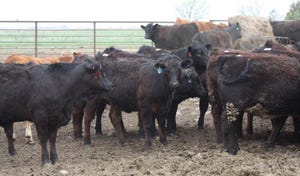December 29, 2015

According to the North Dakota State University (NDSU) Cow Herd Appraisal of Performance Software (CHAPS), the average replacement rate for participating herds is 15.7%. Once a rancher has targeted the number of additional heifers to retain from the calf crop or purchase elsewhere, there are several considerations to determine which heifer stays and which heifer goes.
Carl Dahlen, NDSU Extension beef cattle specialist, offers eight strategies for selecting replacement heifers based on specific criteria. While each rancher might implement his own strategies, based on his operational goals for the beef herd, these eight tips encompass many of the basic considerations:
 1. Target parentage based on desired criteria
1. Target parentage based on desired criteria
Dahlen says, “A thorough evaluation of mature females in a herd may identify cows from which we simply don’t want to keep calves. Cows or cow families that are overly aggressive, have a history of heavy calves or calving difficulty, or are too large, too small or otherwise do not match our vision of a structurally sound female, may be good candidates to remove.”
2. Have a vision of your “ideal” phenotype
Every rancher has the image of his “ideal” cow in his mind. Of course, these ideals can vary based on who you ask; however, phenotype characteristics are moderately heritable, says Dahlen. “Keeping heifers of an ideal phenotype through time will result in future generations having a greater likelihood of similar phenotype. This criteria can be limiting quickly if the ‘ideal’ phenotype desired is not present in the cow herd.”
3. Keep older heifers
“Early-born heifers are older and often heavier at weaning, compared with their later-born contemporaries,” says Dahlen. “Early-born heifers also have a greater chance of becoming pregnant earlier than later-born herd mates.”
4. Cull female twins to male calves
Don’t forget that freemartin heifers (females born twin to a male calf) are infertile and should automatically be culled from the replacement group.
5. Evaluate growth performance/heifer size
“Some producers use the growth rate from birth to weaning, or from weaning to a yearling age, as a selection criteria,” says Dahlen. “The same selection pressure likely is used, indirectly, if the biggest heifers are selected at any given time point. You must use caution with this selection criteria to stay away from selecting extremes that have potential to move mature weights away from your ideal (mature females that are too small or too large).”
6. Study the EPDs & genomics
For purebred cattle, EPDs can be used as a selection tool, and producers can prioritize EPD traits when selecting females. For more information about using EPDs to make breeding decisions, click here.
Genomic panels are also available to assist with selecting replacement heifers. Dahlen says, “Heifers may look alike and meet all other selection criteria; genomic results can be used to narrow the replacement pool to a target number. If using genomic panels, consider using traits that are of high value to cow herd profitability.”
7. Look at the reproductive tract scores/pelvic measurements
About 45 days before the breeding season, a veterinarian can evaluate the reproductive tract and pelvic measurements of the heifers, assigning a score of 1 to 5. This test can help identify heifers with narrow pelvic areas that might go on to have calving difficulty. It can also identify the freemartins in the group.
8. Select to achieve early pregnancy
Dahlen writes, “Selecting only heifers that become pregnant early (to the first artificial insemination or during the first 21 days of a natural-service bull exposure) can have major impacts on herd reproductive rate and productivity. Heifers becoming pregnant early have greater longevity and wean more and heavier calves, compared with heifers becoming pregnant later in the breeding season.”
Of course, this means retaining a larger number of heifers, which can be limiting based on the forage and feed resources available; however, this strategy can pay off greatly when heifers calve in a tighter window resulting in a more uniform calf crop. It also identifies those that will be able to breed back sooner in the upcoming breeding season.
What are your strategies for selecting replacement heifers? Are you retaining just enough to maintain numbers, or are you in expansion mode this year? Share your thoughts in the comments section below.
The opinions of Amanda Radke are not necessarily those of beefmagazine.com or Penton Agriculture.
You might also like:
7 ranching operations who lead in stewardship, sustainability
Why we need to let Mother Nature select replacement heifers
Photo Gallery: Laugh with Rubes cow cartoons
Beta agonists wrongly blamed for fatigued cattle syndrome
You May Also Like



